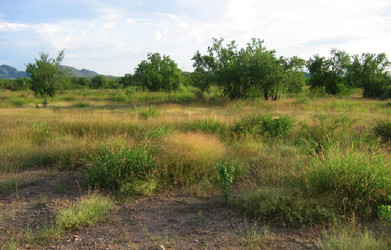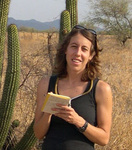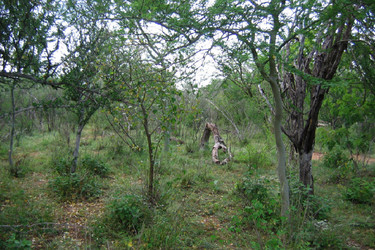Kim Franklin is a PhD student at the University of Arizona in Interdisciplinary Program in Insect Science. View Kim's CIS homepage.
For the past two years I have been studying the effects of converting native habitats to buffelgrass pastures on biodiversity in Sonora, Mexico. I am comparing the ant diversity in buffelgrass pastures to that of native habitats in Sonora.
Buffelgrass (Pennisetum ciliare) is a species of grass native to Africa. It produces a large amount of biomass, which when dry, is highly flammable. Our native desert plants evolved without fire and most are not able to withstand the fires spread by buffelgrass. Scientists are concerned that the spread of buffelgrass in the Sonoran Desert will lead to a loss of biodiversity. Despite this threat, ranchers continue to remove native plants and plant buffelgrass in the hopes that they will be able to raise more cattle. In essence, the natural desert habitat is being converted into an artificial savanna habitat, and although there has been no investigation into the consequences for the animal species living in Sonora, we suspect that many may become locally extinct.


Buffelgrass Pasture Pennisetum ciliare. © 2007
I am comparing the ant diversity in buffelgrass pastures to that of native habitats in Sonora. Ants are a very important component of desert ecosystems. They are “ecosystem engineers,” which means that the things that ants do in their environment greatly affect other organisms in the environment.2 For example, as ants are excavating their underground nests they bring soil from deep underground to the surface and thus are very important to soil nutrient cycling. A particularly important group of ants in the Sonoran Desert are called seed harvester ants. Their name refers to the fact that these ants collect or “harvest” the seeds of many native plants. In doing so they can influence the number and distribution of these plants in the environment.
Experimental Design
The first thing to note about this study is that it is an observational study as opposed to an experimental study, which means that I have not altered my study sites in any way. In an experimental study the scientist herself alters the environment in some way whereas in an observational study the scientist does not alter the environment. In most circumstances scientists prefer to conduct an experimental study because stronger conclusions can be drawn from experimental studies than from observational studies. This is because the scientist has more control over the experimental conditions.
I currently have 15 pairs of study sites, each pair consisting of one buffelgrass pasture and one native desert pasture that hasn’t been planted with buffelgrass. In selecting these pairs of study sites I tried to ensure that each pair of sites were as similar to each other as possible in every way other than the presence of buffelgrass. It was very important in designing this study to compare pairs of study sites because this gives some control over environmental conditions other than buffelgrass that could affect ant diversity.
As an example, let’s consider our observational study of schoolyard diversity. In comparing the diversity of arthropods in different microhabitats, it will be difficult to say for sure what about the microhabitat is responsible for differences in diversity because the microhabitats differ in more than one way. On the other hand, if we had took two identical microhabitats and altered one in some way and then measured the response of a certain variable, such as arthropod diversity, we could be more sure that our alteration was responsible for the observed changes. In my case I am interested in learning how the spread of buffelgrass in the Sonoran Desert is affecting biodiversity. Ideally I would be able to control the conditions in each of my pastures, but this is impossible. I have to accept that there may be factors other than simply the presence or absence of buffelgrass that might influence ant diversity in my study sites. Can you think of some of these other factors?
Just as you are using pitfall traps in your own schoolyards if you are conducting the Arthropod Investigation, I am using pitfall traps to sample the diversity of ants and other ground dwelling arthropods in each pasture. I place 36 pitfall traps in every pasture for a period of 72 hours. I have collected all of my traps and have been able to sort through some of the data, which are provided to you below. In sorting the data I made the same measurements you might make from your schoolyard data. I counted both the number of ants and the number of species that fell into the 36 pitfall traps in each habitat. Your job is to make charts of the data that show the differences in diversity and abundance of ants in buffelgrass pastures and desert pastures.
The Total Number of Individual Ants
| | Desert Habitat | Buffelgrass Habitat |
| PAIR 1 | 1001 | 273 |
| PAIR 2 | 1029 | 444 |
| PAIR 3 | 576 | 388 |
| Desert Habitat | Buffelgrass Habitat | |
| PAIR 1 | 19 | 17 |
| PAIR 2 | 22 | 19 |
| PAIR 3 | 23 | 20 |
The Total Number of Species
By comparing the abundance and diversity of ants in these two habitats we are able to begin exploring the effects of this habitat change. In order to understand why we see these changes we would need to conduct further experiments. For example, if we find that a certain species of seed harvester ant is always absent from buffelgrass pastures we might hypothesize that this ant species may not be able to collect buffelgrass seeds, but we would need to conduct additional research to test this hypothesis.






 Go to quick links
Go to quick search
Go to navigation for this section of the ToL site
Go to detailed links for the ToL site
Go to quick links
Go to quick search
Go to navigation for this section of the ToL site
Go to detailed links for the ToL site